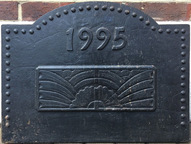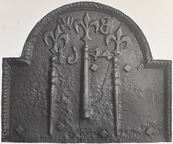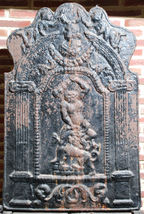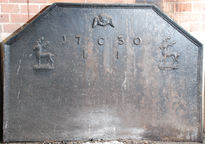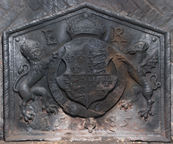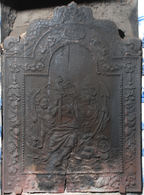-
1026
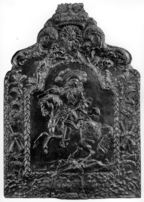 ? x ? mm
? x ? mmDescription: Arched rectangular central panel with overlapping leaf bud edging; prancing equestrian figure of a man in late-seventeenth century dress, with a plumed tricorn hat, his head turned to his left, his left hand holding the reins and his right hand pointing a baton beside the horse's head; quasi-arched rectangular border with overlapping leaf bud edging enclosing martial emblems (cannon, helmets etc.) to left and right, and surmounted by two reclining female figures, that to the left blowing a hunting horn, and that to the right supporting a cornucopia; between them, a sun in splendour, above which is a royal crown; at the bottom corrosion through use and damage has rendered the decoration indistinct.
Notes: The sun in splendour suggests that the figure is that of Louis XIV, of France, but the 'Dutch' style makes this less likely; an alternative identification might be Crown Prince Frederick (later King Frederick IV) of Denmark, of whom other fireback representations exist in a similar pose and with similar martial accoutriments.
- Decoration tags:
- 'Dutch' (shape)
- overlapping leaf bud (edging)
- whole carved pattern
- pictorial
- royal
- animals
- humans
- objects
Manufactured: in the late-17th century in Germany.
Current location:, not known.
- Attached to series:
- 'Dutch' Miscellaneous Firebacks
-
1266
Description: Arched rectangular shape; plain edge with 49 large beads parallel with top and sides; upper centre, date in bold Arabic numerals; below date, raised rectangular panel with chamfered sides and corners and fillet edging, and a symmetrical sunburst and rainbow design in low relief.
Notes: Modern, quasi-Art Deco design
Inscription: 1995
- Decoration tags:
- rectangular with round arch (shape)
- none (edging)
- whole carved pattern
- individual numbers
- text
- objects
Manufactured: in 1995 in England.
Current location: in private hands Croydon, Greater London, England.
- Attached to series:
- Miscellaneous pattern firebacks
- 1990s Art Deco series
-
340
Description: Arched rectangular shape; gadrooned edging (top and sides); initials, in separate stamps, at top of arch; date in separate stamps, split by central spindle, below; two different spindles used as stamps, one centrally between splitting initial stamps, the other repeated twice on each side, slightly lower; above each spindle a fleur-de-lys stamp.
Notes: It is possible that the initials were intended to be 'BW' but that it was forgotten that they needed to be reversed when impressed into the mould. The same base board has been used for other firebacks dating from 1622 and 1632, and the central spindle can be be seen on another fireback of 1644. Purchased by J. H. Every at Bigges Farm, Cuckfield, Sussex, in 1918.
Inscription: W B / 16 44
- Decoration tags:
- rectangular with round arch (shape)
- gadrooned (edging)
- simple stamps
- individual letters
- individual numbers
- text
- objects
Manufactured: in 1644 possibly at Cuckfield Furnace in the Weald area of England.
Current location: not known.
Citation: Hughes, G. B., 21 Apr 1955, 'Old English Firebacks', Country Life, 117, pp. 1056-60.
Citation: Hughes, G. B., May 1940, 'Old English Firebacks', Apollo, 31, 185, pp. 117-120.
- Attached to series:
- Spindle series
- Spindle/distaff firebacks
-
44
Description: Rectangular; astragal edging; simple diamond pattern covering whole plate, formed from evenly-spaced diagonal lines.
- Decoration tags:
- rectangular (shape)
- astragal (edging)
- whole carved pattern
- objects
Manufactured: .
Current location: in private hands, Cuckfield, West Sussex, England.
- Attached to series:
- Miscellaneous pattern firebacks
-
45
Description: Rectangular; ovolo-moulded, gadrooned edging (top and sides); a vertical spindle or chair leg surmounted by a fleur-de-lys arranged three times; the date split by the middle fleur-de-lys.
Notes: The fleur-de-lys is separately stamped from the spindle, and the same spindle is seen on another fireback of the same date.
Inscription: 1641
- Decoration tags:
- rectangular (shape)
- gadrooned (edging)
- simple stamps
- carved stamps
- individual numbers
- heraldic
- text
- objects
Manufactured: in 1641 possibly at Cuckfield Furnace in the Weald area of England.
Current location: in private hands, Cuckfield, West Sussex, England.
- Attached to series:
- Spindle series
- Spindle/distaff firebacks
- Fleur-de-lys firebacks
-
46
Description: Ionic columns supporting a semi-circular arch, in the centre of which the bust of a man has a floral swag beneath; below is a quasi-arched rectangle of beads within which is the figure of Hercules, wielding a club, slaying the Nemean Lion; beneath are floral scrolls; on top of the main arch two kneeling putti hold a wreath over the bust.
Notes: Not the standard 'Dutch' type, which may indicate a different origin. Copies of this fireback were advertised in Burton Weir's (Rotherham) catalogue in the early-20th century.
Copies of this fireback are known.
- Decoration tags:
- 'Dutch' (shape)
- fillet (edging)
- whole carved pattern
- pictorial
- mythological
- animals
- humans
- objects
Manufactured: in the early- to mid-18th century in England.
Current location: in private hands, Cuckfield, West Sussex, England.
- Attached to series:
- Late pictorial series (all)
- Late pictorial series 6
-
47
Description: Rectangular with canted top corners; ovolo-moulded edging (except base); top centre, cherub face and wings; below, date separated by initials in triad on either side of which a stag statant on a chapeau.
Notes: The cherub is similar, but not identical to those on a fireback, of 1713, from Ashburnham, and the layout and edging are also similar.
Inscription: 17 ICI [triad] 30
- Decoration tags:
- rectangular with canted top corners (shape)
- ovolo (edging)
- carved stamps
- individual letters
- individual numbers
- heraldic
- text
- animals
- humans
Manufactured: in 1730 possibly at Ashburnham Furnace in the Weald area of England.
Current location: in private hands, Cuckfield, West Sussex, England.
- Attached to series:
- Miscellaneous stamp firebacks
-
40
Description: Pentagonal; convex, twisted cloth edging with inner fillet; Tudor royal shield, garter, crown and supporters (crowned lion and dragon); initials split by crown; date split by garter buckle.
Notes: Royal arms of Queen Elizabeth I; uncommon edging.
Inscription: E R / HONY SOIT QVI MAL Y PENSE / 1585
Arms: Tudor royal (Elizabeth I)
- Decoration tags:
- triangular arched (shape)
- convex, twisted cloth with inner fillet (edging)
- whole carved pattern
- individual numbers
- armorial
- royal
- text
Manufactured: in 1585 in the Weald area of England.
Current location: in private hands, Cuckfield, West Sussex, England.
- Attached to series:
- Elizabethan royal armorial firebacks
- Tudor royal armorial firebacks
-
41
Description: Arched rectangular shape; rope edging (top and sides); Tudor royal shield, garter, crown and supporters (crowned lion and dragon); date above crown; empty motto compartment with initials below.
Notes: Identical arms can be seen on fireback formerly at Baynards Park, Cranleigh (no. 200), and on one in private hands at Maresfield (no. 482), neither of which have the motto compartment; minor variations in the position of individual elements indicate that the garter and shield, crown, and each supporter were separately stamped; the initials are likely to be those of Henry Bowyer, ironmaster (d.1588), the fireback perhaps being made in his memory.
Inscription: 1588 HB
Arms: Tudor royal (Elizabeth I)
- Decoration tags:
- rectangular with round arch (shape)
- rope (edging)
- carved stamps
- individual letters
- individual numbers
- armorial
- royal
- text
- objects
Manufactured: in 1588 possibly at Pounsley Furnace, Framfield in the Weald area of England.
Current location: in private hands, Cuckfield, West Sussex, England.
-
42
Description: Arched rectangular shaped central panel with bead edging; pictorial scene of a seated female figure resting against a hurdle, holding an anchor, a child on each side of her, the one on the left standing clutching corn stalks, the one on the right sitting also holding the anchor and a circular object; a bird sits on a post; arched rectangular shaped border with fillet edging, containing floral swags suspended from a wreath; on top, a scallop shell between two dolphins.
Notes: The figure represents Hope. The theft in 1699 from a Thames-side warehouse of several firebacks, including '3 of Hope with an Anchor' may refer to this type (Post Boy 11-14 Nov. 1699).
Copies of this fireback are known.
- Decoration tags:
- 'Dutch' (shape)
- fillet (edging)
- whole carved pattern
- pictorial
- allegorical
- animals
- humans
- objects
Manufactured: in the mid- to late-17th century in the Siegerland area of Germany.
Current location: in private hands, Cuckfield, West Sussex, England.
- Attached to series:
- 'Dutch' Miscellaneous Firebacks
- Hope firebacks
